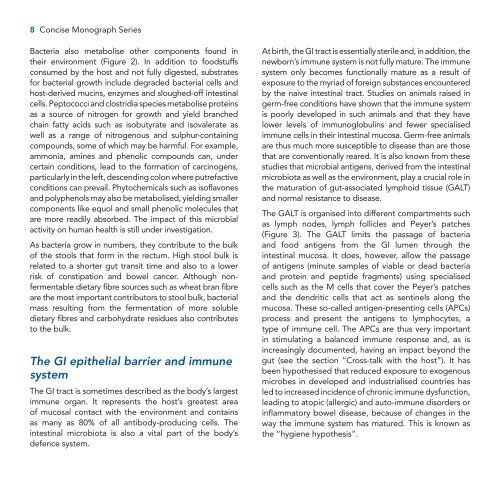probiotics, prebiotics and the gut microbiota - International Life ...
probiotics, prebiotics and the gut microbiota - International Life ...
probiotics, prebiotics and the gut microbiota - International Life ...
Create successful ePaper yourself
Turn your PDF publications into a flip-book with our unique Google optimized e-Paper software.
8 Concise Monograph SeriesBacteria also metabolise o<strong>the</strong>r components found in<strong>the</strong>ir environment (Figure 2). In addition to foodstuffsconsumed by <strong>the</strong> host <strong>and</strong> not fully digested, substratesfor bacterial growth include degraded bacterial cells <strong>and</strong>host-derived mucins, enzymes <strong>and</strong> sloughed-off intestinalcells. Peptococci <strong>and</strong> clostridia species metabolise proteinsas a source of nitrogen for growth <strong>and</strong> yield branchedchain fatty acids such as isobutyrate <strong>and</strong> isovalerate aswell as a range of nitrogenous <strong>and</strong> sulphur-containingcompounds, some of which may be harmful. For example,ammonia, amines <strong>and</strong> phenolic compounds can, undercertain conditions, lead to <strong>the</strong> formation of carcinogens,particularly in <strong>the</strong> left, descending colon where putrefactiveconditions can prevail. Phytochemicals such as isoflavones<strong>and</strong> polyphenols may also be metabolised, yielding smallercomponents like equol <strong>and</strong> small phenolic molecules thatare more readily absorbed. The impact of this microbialactivity on human health is still under investigation.As bacteria grow in numbers, <strong>the</strong>y contribute to <strong>the</strong> bulkof <strong>the</strong> stools that form in <strong>the</strong> rectum. High stool bulk isrelated to a shorter <strong>gut</strong> transit time <strong>and</strong> also to a lowerrisk of constipation <strong>and</strong> bowel cancer. Although nonfermentabledietary fibre sources such as wheat bran fibreare <strong>the</strong> most important contributors to stool bulk, bacterialmass resulting from <strong>the</strong> fermentation of more solubledietary fibres <strong>and</strong> carbohydrate residues also contributesto <strong>the</strong> bulk.The GI epi<strong>the</strong>lial barrier <strong>and</strong> immunesystemThe GI tract is sometimes described as <strong>the</strong> body’s largestimmune organ. It represents <strong>the</strong> host’s greatest areaof mucosal contact with <strong>the</strong> environment <strong>and</strong> containsas many as 80% of all antibody-producing cells. Theintestinal <strong>microbiota</strong> is also a vital part of <strong>the</strong> body’sdefence system.At birth, <strong>the</strong> GI tract is essentially sterile <strong>and</strong>, in addition, <strong>the</strong>newborn’s immune system is not fully mature. The immunesystem only becomes functionally mature as a result ofexposure to <strong>the</strong> myriad of foreign substances encounteredby <strong>the</strong> naive intestinal tract. Studies on animals raised ingerm-free conditions have shown that <strong>the</strong> immune systemis poorly developed in such animals <strong>and</strong> that <strong>the</strong>y havelower levels of immunoglobulins <strong>and</strong> fewer specialisedimmune cells in <strong>the</strong>ir intestinal mucosa. Germ-free animalsare thus much more susceptible to disease than are thosethat are conventionally reared. It is also known from <strong>the</strong>sestudies that microbial antigens, derived from <strong>the</strong> intestinal<strong>microbiota</strong> as well as <strong>the</strong> environment, play a crucial role in<strong>the</strong> maturation of <strong>gut</strong>-associated lymphoid tissue (GALT)<strong>and</strong> normal resistance to disease.The GALT is organised into different compartments suchas lymph nodes, lymph follicles <strong>and</strong> Peyer’s patches(Figure 3). The GALT limits <strong>the</strong> passage of bacteria<strong>and</strong> food antigens from <strong>the</strong> GI lumen through <strong>the</strong>intestinal mucosa. It does, however, allow <strong>the</strong> passageof antigens (minute samples of viable or dead bacteria<strong>and</strong> protein <strong>and</strong> peptide fragments) using specialisedcells such as <strong>the</strong> M cells that cover <strong>the</strong> Peyer’s patches<strong>and</strong> <strong>the</strong> dendritic cells that act as sentinels along <strong>the</strong>mucosa. These so-called antigen-presenting cells (APCs)process <strong>and</strong> present <strong>the</strong> antigens to lymphocytes, atype of immune cell. The APCs are thus very importantin stimulating a balanced immune response <strong>and</strong>, as isincreasingly documented, having an impact beyond <strong>the</strong><strong>gut</strong> (see <strong>the</strong> section “Cross-talk with <strong>the</strong> host”). It hasbeen hypo<strong>the</strong>sised that reduced exposure to exogenousmicrobes in developed <strong>and</strong> industrialised countries hasled to increased incidence of chronic immune dysfunction,leading to atopic (allergic) <strong>and</strong> auto-immune disorders orinflammatory bowel disease, because of changes in <strong>the</strong>way <strong>the</strong> immune system has matured. This is known as<strong>the</strong> “hygiene hypo<strong>the</strong>sis”.
















